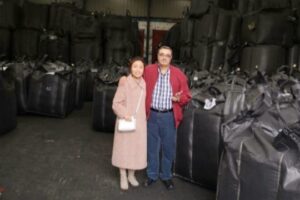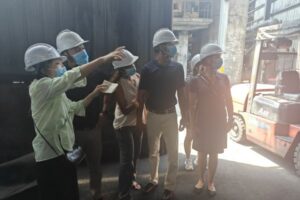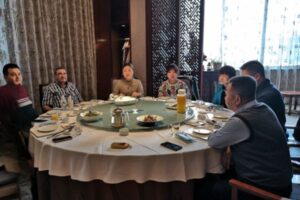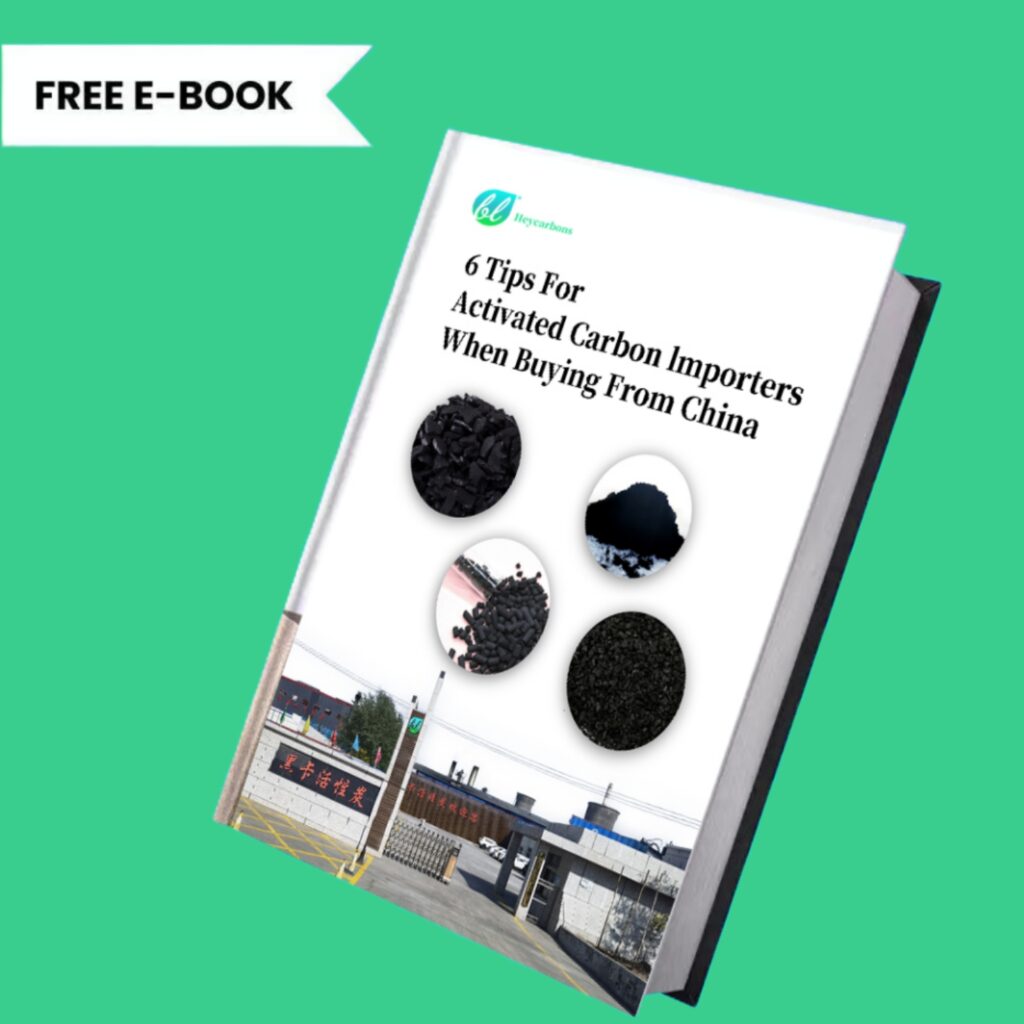Copper Iron Magnesium Cu-Fe-Mg Impregnated Activated Carbon
What is Copper Iron Magnesium Cu-Fe-Mg Impregnated Activated Carbon?
Copper iron magnesium Cu-Fe-Mg impregnated activated carbon is a functional adsorption material made by impregnating copper, iron, magnesium and other metal oxides or compounds in an activated carbon substrate.
This material has high gas adsorption performance and catalytic ability, and is widely used in environmental governance, industrial waste gas treatment and high-end air purification.
Copper iron magnesium Cu-Fe-Mg impregnated activated carbon is usually coconut shell granular activated carbon or coal columnar activated carbon.

Copper Iron Magnesium Cu-Fe-Mg Impregnated Activated Carbon Process
For copper iron magnesium Cu-Fe-Mg impregnated activated carbon impregnation process, there are two production methods of metal oxide impregnated activated carbon, which are divided into pre-process and post-process.
The pre-process is to impregnate the metal oxides during the activated carbon production process, while the post-process is to impregnate the metal oxides after the activated carbon production is completed.
Impregnation with Copper Oxide (CuO)
When impregnating copper oxide CuO, since copper oxide CuO is insoluble in water, basic copper carbonate Cu2(OH)2CO3 needs to be dissolved in amine water, and then roasted to become copper oxide CuO after impregnation.
Impregnation with Magnesium Oxide (MgO)
When impregnating magnesium oxide MgO, since magnesium oxide MgO is insoluble in water, the impregnation liquid can be a magnesium oxide MgO precursor solution, such as magnesium chloride MgCl₂ or magnesium nitrate Mg(NO₃)₂ solution, to ensure uniform impregnation.
A suspension of magnesium oxide MgO dispersed in water or an organic solvent can also be used. After impregnation, it is calcined to become magnesium oxide MgO.
Impregnation with Iron Oxide (Fe2O3)
When impregnating iron oxide Fe2O3, since iron oxide Fe2O3 is insoluble in water, soluble iron salts (such as iron nitrate Fe(NO₃)₃, iron chloride FeCl₃) can be used to prepare an impregnation solution of appropriate concentration. After impregnation, it is calcined to become iron oxide Fe2O3.
You will get a quote in 24 hours
You will get a quote in 24 hours
Copper Iron Magnesium Cu-Fe-Mg Impregnated Activated Carbon Applications
Sulfur Dioxide (SO2) Removal
At lower temperatures, coconut shell granular activated carbon can be selected. It has the best effect in adsorbing SO2 in an environment of room temperature to 150°C.
Coal-based columnar activated carbon has a wide range of temperature adaptability (room temperature to 300°C) and performs better when used in high temperature environments, but its adsorption performance will decrease when it exceeds 300°C.
Alkaline compound impregnation method: Alkaline compounds, such as KOH, NaOH, K2CO3, KOH+KI, etc., can react with SO2 to form sulfate, thereby improving the adsorption capacity of activated carbon for SO2. The price is relatively cheap.
Oxidizing metal impregnation method: Some oxidizing metals such as CuO and MgO can catalyze the oxidation of SO2, thereby improving the adsorption efficiency. But the price is relatively expensive.
Hydrogen Sulfide (H2S) Removal
Copper iron magnesium Cu-Fe-Mg impregnated activated carbon has excellent removal and adsorption performance for hydrogen sulfide.
Its advantage is that, compared to KOH impregnated activated carbon, the ignition point of copper iron magnesium Cu-Fe-Mg impregnated activated carbon after impregnation does not decrease.
After the activated carbon is saturated with KOH, there is KOH-free on the activated carbon after regeneration, and the working sulfur capacity drops significantly. After copper iron magnesium Cu-Fe-Mg impregnated activated carbon is regenerated after saturation, the working sulfur capacity has slightly decreased and still maintains a strong H2S adsorption capacity. The price of copper iron magnesium Cu-Fe-Mg impregnated activated carbon is higher than that of KOH impregnated activated carbon.
Petrochemical Industry
Activated carbon based carbon of CTC60 or CTC70 can be used to enhance the desulfurization effect by impregnation with copper oxide CuO.
Copper Cu impregnated activated carbon can be used for desulfurization reactions, especially in hydrogenation processes and waste gas treatment systems in petrochemical plants, where it can adsorb and convert hydrogen sulfide H2S.
Catalytic Reaction
Copper iron magnesium Cu-Fe-Mg impregnated activated carbon can also be used for catalytic reactions.
Copper iron magnesium Cu-Fe-Mg metal ions can enhance the stability of activated carbon at high temperatures and prevent pyrolysis or structural damage to activated carbon during the catalytic process.
The introduction of metal elements not only improves the efficiency of the catalytic reaction, but also improves the pore structure of activated carbon, enabling it to carry more reactants and catalytic products.
Copper iron magnesium Cu-Fe-Mg impregnated activated carbon can be used in many aspects:
- Gas purification reaction: used in waste gas treatment and environmental protection, VOCs degradation)
- Water treatment reaction: remove chloride, iron plays a catalytic role in the Fenton reaction, and is widely used in the degradation of organic pollutants in water
- Organic synthesis reaction.
Water Treatment Desulfurization
Copper oxide (CuO) can react with hydrogen sulfide and certain heavy metal ions in water to remove pollutants. Copper Cu impregnated activated carbon can absorb sulfides (such as hydrogen sulfide H2S), heavy metals (such as lead, mercury) and organic pollutants in water, especially in the treatment of industrial wastewater, effectively removing harmful substances in water.
Silver or copper loaded coconut shell activated carbon can also be used.
Gas Masks
Impregnated activated carbon can be used to prepare adsorbents in gas masks, which can effectively remove and adsorb toxic gases such as organic gases (benzene, methane, etc.), hydrogen sulfide (H2S), hydrogen cyanide (HCN), chlorine (Cl2), ammonia (NH3), etc.
The activated carbon used in gas masks is generally 0.9mm base carbon, loaded with gold, silver and copper. The specific parameters of coconut shell granules impregnated activated carbon that can be used for gas masks are shown in the table below.

| Project | Impregnant content | Weight | |
|---|---|---|---|
| Specification | 16x30mesh | Cu (Copper) | min.6% |
| Surface area | 1000-1200 m2/g | Mo (Molybdenum) | min.2.5% |
| Iodine value | 1000mg/g | Zn (Zinc) | 3.5-6% |
| Hardness | ≥98% | Ag (silver) | 0.03-0.1% |
| Bulk density | 0.45-0.55g/cm3 | TEDA | 2-3.5% |
| Moisture | <2% | ||
| Ash | <3% |
You will get a quote in 24 hours
You will get a quote in 24 hours
Impregnated Activated Carbon Combined with Fe2O3, KOH and kI
Function and Principle
Potassium hydroxide KOH reacts with activated carbon at high temperature, which further develops the pore structure of activated carbon and increases the specific surface area and pore volume. The presence of iron oxide Fe2O3 may affect the reaction process and degree of potassium hydroxide KOH and activated carbon to a certain extent, play a role in regulating the pore structure, make the pore distribution more reasonable, and facilitate the adsorption of molecules of different sizes.
Iron oxide Fe2O3 itself has a certain catalytic activity. When it works together with potassium hydroxide, the alkaline environment adjusted by potassium hydroxide KOH is conducive to the adsorption and activation of certain reactants, and iron oxide Fe2O3, as an active center, can promote some redox reactions. The two work together with activated carbon to enhance the catalytic performance of activated carbon.
As an oxidant and reaction aid, KI can enhance the adsorption capacity of organic pollutants. At the same time, iron oxide Fe2O3 can participate in the catalytic decomposition of organic pollutants and improve the removal efficiency.
Application
Energy field
- Supercapacitor: It can be used to prepare electrode materials for supercapacitors. After the iron oxide Fe2O3 and potassium hydroxide KOH are jointly impregnated, the specific capacitance and cycle stability of activated carbon can be improved, making the supercapacitor have better energy storage performance.
Hydrogen H2 adsorption and storage: Activated carbon activated by potassium hydroxide KOH can be used for hydrogen H2 adsorption and storage. The addition of iron oxide Fe2O3 can improve its hydrogen H2 adsorption capacity, especially under low temperature conditions. Iron oxide Fe2O3 helps the physical and chemical adsorption of hydrogen H2. KI, as an auxiliary chemical component, may enhance the reactivity with hydrogen molecules and help improve the hydrogen storage density.
Environmental governance field
- Wastewater treatment: It can be used to treat wastewater containing heavy metal ions. Through ion exchange and adsorption, it can remove heavy metal ions such as mercury, lead, and cadmium in wastewater. It can also adsorb organic pollutants in wastewater, such as phenols and dyes, reduce the chemical oxygen demand (COD) and biochemical oxygen demand (BOD) of wastewater, improve the biodegradability of wastewater, and create conditions for subsequent biochemical treatment.
- Waste gas treatment: It can effectively adsorb acidic and harmful gases such as sulfur dioxide SO2 and nitrogen oxides NOx in industrial waste gas, and is widely used in waste gas treatment in power, chemical and other industries. It also has good adsorption and catalytic oxidation effects on volatile organic compounds (VOCs) in industrial waste gas, and can convert VOCs into carbon dioxide and water, reducing the emission of organic waste gas.
You can get more information about impregnated activated carbon from here:
Impregnated Activated Carbon
What Our Clients Say Us


Custom Heycarb Impregnated Activated Carbon Solution
Heycarbons provides a full range of activated solutions at competitive prices.
You will get a quote in 24 hours













